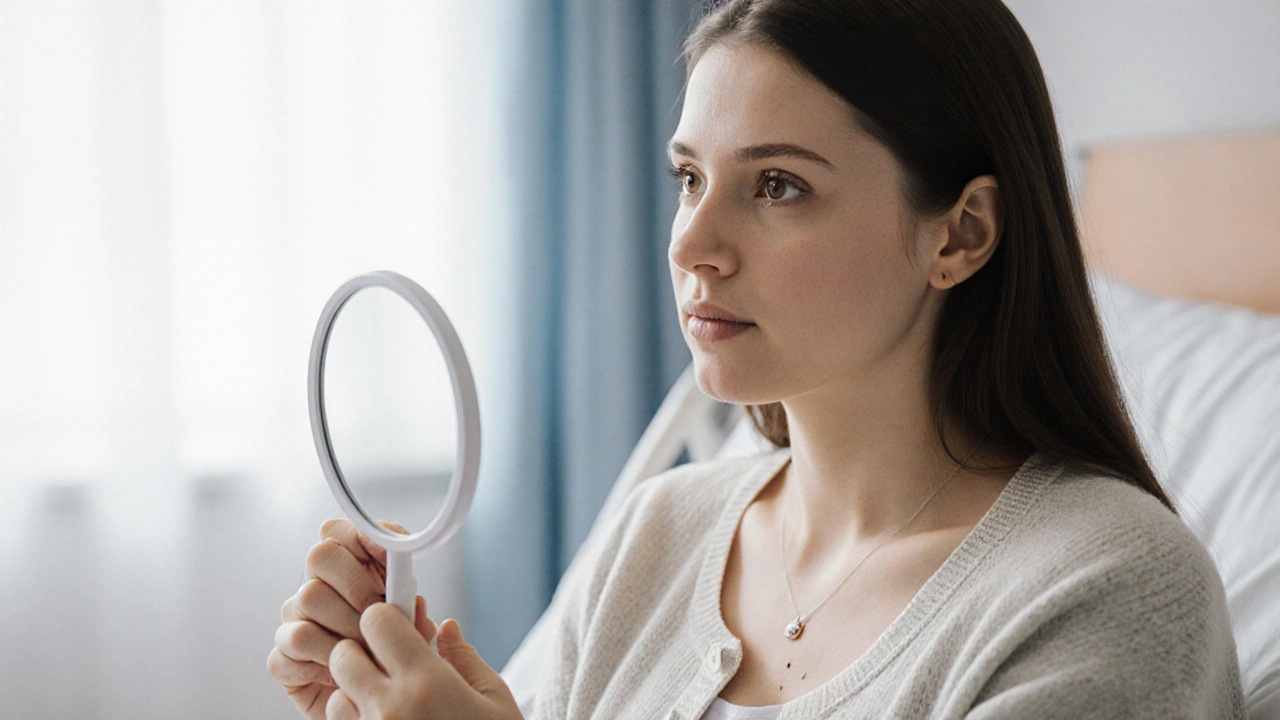Breast Cancer Body Image Impact Calculator
Calculate Your Body Image Impact
Select the treatments you're undergoing to understand potential effects on your body image and self-esteem.
Your Body Image Impact Assessment
This score reflects how breast cancer treatments may affect your body image and self-esteem.
Impact by Treatment Type
Recommended Coping Strategies
When someone receives a diagnosis of Breast Cancer is a malignant growth in breast tissue that can change a person's life in many ways, thoughts about how the body looks often surface immediately.
Key Takeaways
- Breast cancer and its treatments can reshape how you view your body and your confidence.
- Surgery, chemotherapy, and radiation each bring specific body‑image challenges.
- Psychosocial support-counseling, support groups, and peer networks-reduces the negative impact on self‑esteem.
- Practical steps like choosing comfortable clothing, staying active, and discussing intimacy can improve daily wellbeing.
- Professional help is essential if feelings of shame, anxiety, or depression linger.
Why Breast Cancer Touches Body Image and Self‑Esteem
Body image is the mental picture you hold of your own appearance. Self‑esteem is the value you assign to yourself based on that picture. When a disease attacks a part of the body that carries cultural and personal meaning-like the breasts-it can shake both concepts at once.
Research from the American Cancer Society (2024) shows that roughly 60% of women report a noticeable dip in self‑confidence within the first six months after diagnosis. The drop isn’t just skin‑deep; it influences relationships, work performance, and overall quality of life.
How Different Treatments Influence How You See Yourself
Each treatment route brings its own physical changes, and those changes feed into body‑image perception.
Surgery and Mastectomy
Mastectomy is a surgical removal of one or both breasts, often performed to eliminate cancerous tissue. Losing breast tissue can feel like losing a symbol of femininity for many women. Studies indicate that 45% of mastectomy patients initially experience a sharp decline in self‑esteem.
Breast‑Conserving Surgery (Lumpectomy)
Keeping part of the breast can soften the visual impact, but scar tissue and changes in shape still matter. About 30% of lumpectomy patients report lingering concerns about asymmetry.
Reconstruction
Reconstruction aims to restore shape using implants or tissue from other body parts. While many women feel a boost in confidence after reconstruction, the process can involve multiple surgeries and a longer recovery timeline. Approximately 70% say they are satisfied with the final look, yet 20% still struggle with feeling “authentic.”
Chemotherapy
Chemotherapy is a systemic treatment that uses drugs to kill rapidly dividing cancer cells. Hair loss, weight fluctuations, and skin changes are common side effects that can make you feel less attractive. A 2023 survey found 38% of patients link chemotherapy‑induced hair loss directly to reduced self‑esteem.
Radiation Therapy
Radiation can cause skin reddening, tenderness, and sometimes fibrosis (hardening) of the treated area. These visible changes often linger for months, reminding patients of their illness and affecting how comfortable they feel in clothes that expose the chest.
Hormone Therapy
Long‑term hormone blockers can trigger hot flashes, mood swings, and weight gain, all of which can alter body perception over time.

Emotional Ripple Effects on Self‑Esteem
Physical changes are only half the story. The emotional fallout can be profound:
- Shame and secrecy: Many women hide scars or avoid swimsuits, leading to social withdrawal.
- Fear of partner rejection: Concerns about intimacy can erode confidence in relationships.
- Identity shift: The “cancer survivor” label can feel limiting, especially when it replaces previous self‑identities.
These feelings often translate into anxiety or depression if left unchecked. The National Institute of Mental Health (2022) reports that women with breast cancer are twice as likely to experience clinical depression within the first year after treatment.
Practical Coping Strategies
Knowing what works can turn a vague sense of loss into manageable steps.
1. Join a Support Group
Support Group is a regular meeting where people share experiences, advice, and emotional backing. Hearing stories from others who have navigated similar body‑image hurdles can normalize your feelings and provide practical tips.
2. Talk to a Therapist
Licensed counselors trained in oncology psychosocial care can help you reframe negative thoughts and develop coping tools. Cognitive‑behavioral therapy (CBT) has shown a 25% improvement in self‑esteem scores for breast‑cancer survivors.
3. Choose Body‑Positive Clothing
Invest in fabrics that drape comfortably over scars or implants. Many retailers now offer “post‑surgery” bras with soft seams and adjustable straps-these small comforts can make a big difference in how you feel in public.
4. Stay Physically Active
Gentle exercises like yoga, swimming, or walking boost endorphins and improve muscle tone around the chest. A 2021 study reported that regular activity reduced body‑image dissatisfaction by 18% among women undergoing radiation.
5. Communicate with Your Partner
Open conversations about intimacy, fears, and desires help prevent misunderstandings. Many couples find that exploring new forms of affection-like massage or eye‑contact intimacy-re‑establishes closeness without focusing on physical appearance.
Comparing Treatment Types and Their Typical Body‑Image Impact
| Treatment | Physical Change | Typical Body‑Image Issue | Suggested Coping Tip |
|---|---|---|---|
| Mastectomy | Loss of breast tissue | Feeling less feminine | Consider reconstruction or custom prosthesis |
| Lumpectomy | Scar & asymmetry | Self‑conscious about clothing | Targeted scar‑care and fitted tops |
| Reconstruction | Multiple surgeries, implants or flaps | Worry about “authenticity” | Therapy to address identity shift |
| Chemotherapy | Hair loss, weight change | Loss of attractiveness | Wigs, nutrition plan, exercise |
| Radiation | Skin discoloration, stiffness | Avoiding swimwear | Skin‑care regimen, gradual stretching |
| Hormone Therapy | Weight gain, mood swings | Feeling out of shape | Balanced diet, mindfulness practice |

When to Seek Professional Help
If you notice any of these signs lasting more than a few weeks, it’s a cue to reach out:
- Persistent sadness or tearfulness
- Avoidance of social situations because of appearance
- Loss of interest in activities you once loved
- Thoughts that you’re a burden to loved ones
- Physical symptoms like chronic pain that affect mood
Oncologists, mental‑health professionals, and certified cancer‑survivor coaches can work together to create a personalized plan.
Putting It All Together: A Quick Action Plan
Here’s a three‑day starter guide to begin reclaiming body confidence after a breast‑cancer diagnosis:
- Day 1: Write down three things you like about your body right now, even if they’re unrelated to the breast area. Share one with a trusted friend.
- Day 2: Schedule a 30‑minute call with a local support group or an online forum. Listen, then introduce yourself.
- Day 3: Try a gentle activity-stretching, a short walk, or a beginner yoga video-while wearing clothing that feels comfortable over scar sites.
Small, consistent actions build momentum, turning feelings of loss into a renewed sense of agency.
Final Thought
Dealing with breast cancer is a marathon, not a sprint. The physical changes are real, but your response to them can be shaped, too. By understanding the specific ways each treatment impacts body image, leaning on professional and peer support, and taking practical daily steps, you can protect-and even strengthen-your self‑esteem throughout the journey.
Frequently Asked Questions
Can reconstruction fully restore my confidence?
Recovery of confidence varies. Many women feel a boost after reconstruction because the visual change is addressed, but about one‑fifth still experience lingering doubts about authenticity. Ongoing counseling can help align the new body image with self‑identity.
How soon after surgery can I join a support group?
Most groups welcome new members right away, even while you’re still healing. Virtual meetings are especially flexible, letting you participate from home during the early recovery weeks.
Will hair loss from chemotherapy permanently affect my body image?
Hair loss is usually temporary. Most patients see regrowth within 3‑6 months after completing chemo. In the meantime, wigs, scarves, or headbands can maintain the sense of control over appearance.
Is it normal to feel unattractive during radiation therapy?
Yes. Skin changes and fatigue are common, and they can trigger self‑conscious thoughts. Gentle skin‑care, loose‑fit clothing, and talking openly with loved ones can ease the pressure.
How can I talk to my partner about changes in intimacy?
Pick a calm moment, use “I” statements (e.g., “I feel nervous about my scar”), and invite your partner to share feelings too. Exploring new ways to be close-like massage, eye contact, or shared hobbies-helps keep the emotional bond strong.

11 Comments
When we examine the ripples of a breast cancer diagnosis it becomes evident that the trauma is not merely physiological but philosophical in nature. The body, once a vessel of identity, is reframed through the clinical lens of disease and treatment. Each surgical incision or chemotherapy cycle serves as a reminder of mortality, prompting an existential reassessment of self. The loss of breast tissue, for many, is tantamount to a loss of a cultural symbol of femininity and nurturing. This symbolic erosion can precipitate a cascade of self‑esteem deterioration that is both tangible and metaphysical. The patient must navigate a paradox wherein the physical alteration is both a cure and a source of new insecurities. In confronting this paradox, the mind often oscillates between grief for the lost form and hope for renewed resilience. Psychological adaptation, therefore, is not a linear trajectory but a spiral of acceptance, resistance, and integration. Support groups function as communal mirrors reflecting shared fragmented narratives back to the individual. Cognitive‑behavioral therapy provides tools to reconstruct the narrative, allowing the self to be re‑authored beyond the scarred flesh. Physical activity, though seemingly superficial, activates neurochemical pathways that reinforce a sense of agency over the altered body. Clothing choices, while trivial to some, become deliberate expressions of reclaiming dignity amidst vulnerability. The intimacy with a partner can either deepen through honest dialogue or fray under unspoken shame, underscoring the relational dimension of body image. Hormone therapy’s subtle changes remind us that even hormonal whispers can echo loudly in the psyche. Ultimately, the journey is a marathon of continual renegotiation, where each step, each breath, each smile contributes to a mosaic of renewed self‑esteem that transcends the initial impact of disease.
The article is solid but it could tighten the data citations – the percentages feel like placeholders. Also, the table formatting is clunky; a simple markdown would improve readability. A few more recent sources would boost credibility.
Hey there, if you’re feeling down about your body after treatment, remember you’re not alone. Lots of people go through similar feelings and find comfort in sharing stories. Try joining a supportive community online – hearing how others cope can be a real mood‑booster. Also, think about small daily wins: a comfy shirt that feels good, a short walk that makes you feel strong. Little steps add up to big confidence over time.
Honestly, if you keep hiding your scar under baggy clothes, you’re only giving power to the thing that’s haunting you. Show it, own it, and watch the internal narrative shift. It’s not about fashion advice, it’s about confronting the fear head‑on.
Let’s get moving, folks! A quick 10‑minute stretch or a walk can lift mood and remind you that your body still rocks. Keep that energy up and challenge the self‑doubt whenever it pops up.
Oh, the melodrama of “I’m not myself without my breasts!” – as if a piece of anatomy defines the whole of identity. Newsflash: many navigate life brilliantly after reconstruction, or even without it. Perspective, dear.
Quick tip: look for local cancer survivor groups on Meetup – they’re often free and low‑key. You can share experiences without the pressure of a formal therapy setting.
Really, the journey after a diagnosis can feel overwhelming, but remember you’ve already shown immense courage, perseverance, and resilience – qualities that will continue to guide you forward, no matter the challenges that arise.
It helps to set tiny, reachable goals each day – like trying on a favorite top, or sending a message to a friend about how you’re feeling. Those small victories build a sturdy foundation for longer‑term confidence.
Speak up about your feelings; it’s a sign of strength, not weakness.
Remember, you are more than a scar or a treatment plan 😊. Embrace the parts that make you, you, and celebrate each step you take toward feeling whole again 💪.
Write a comment